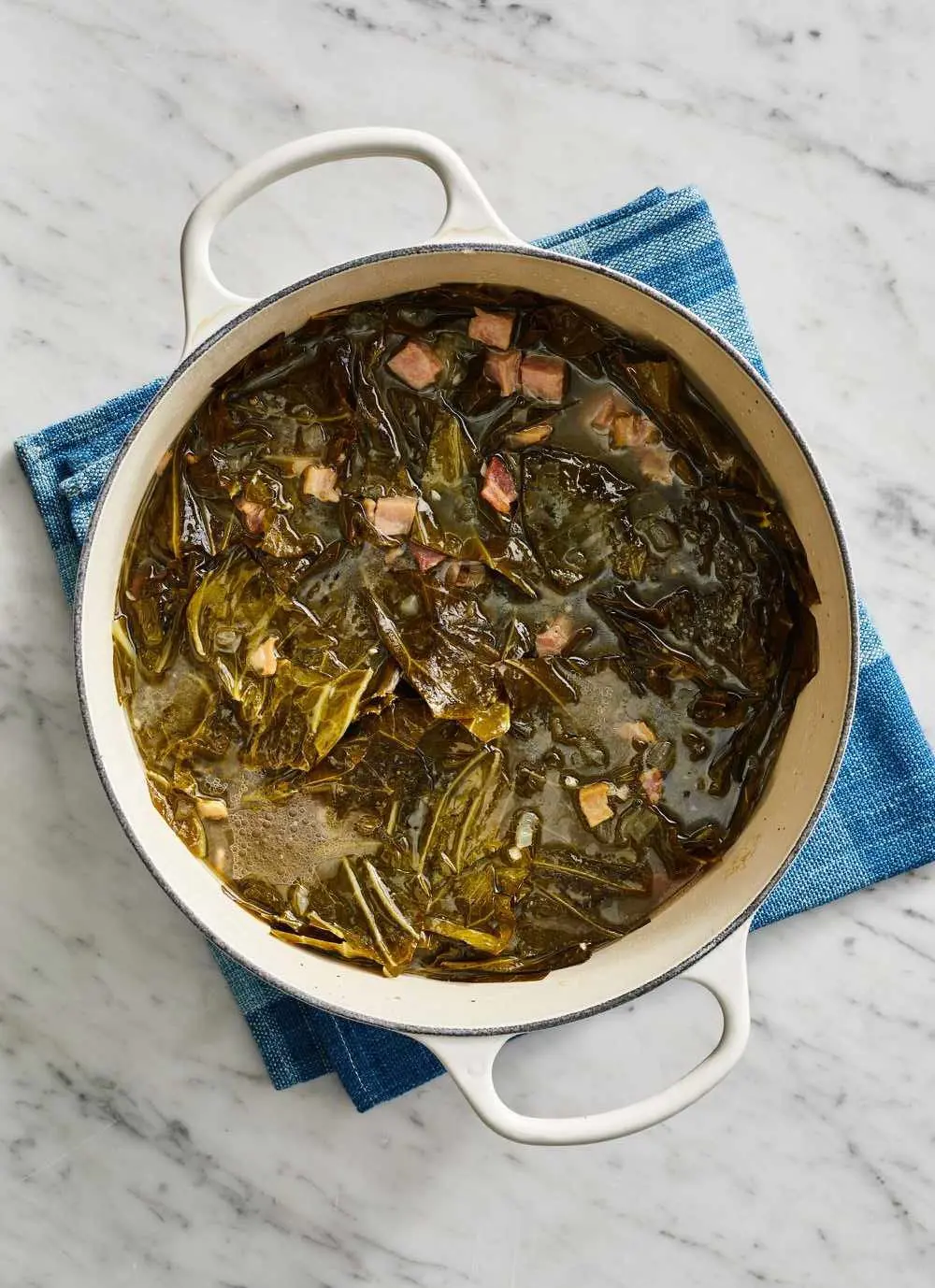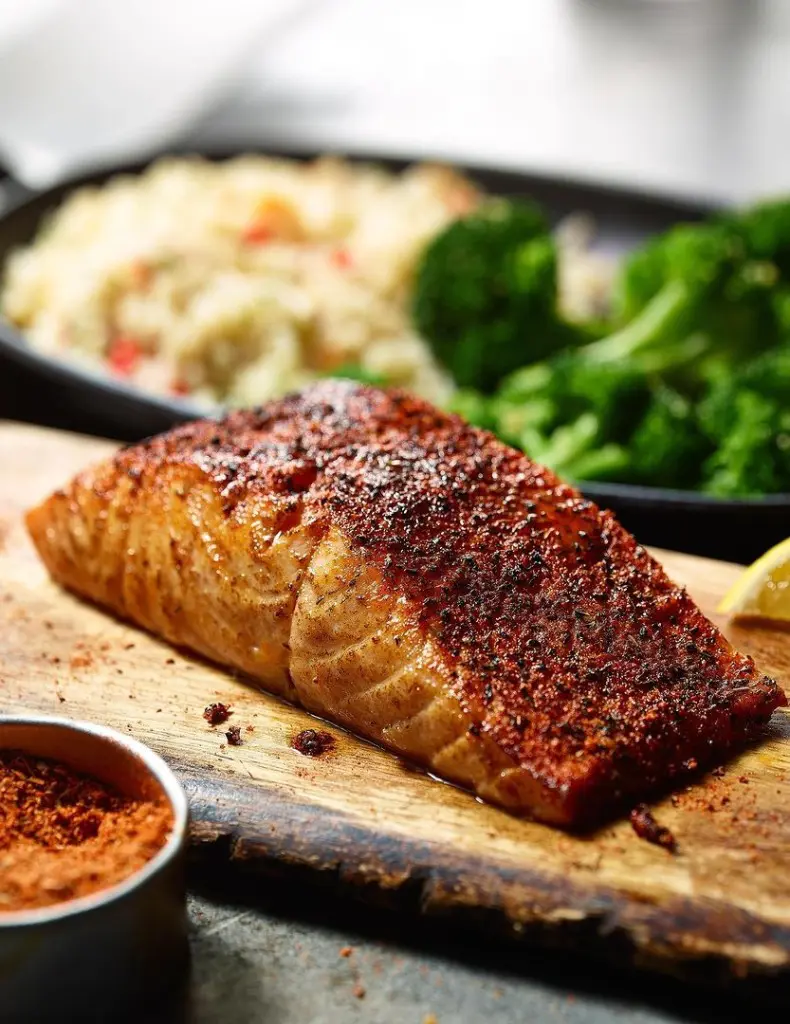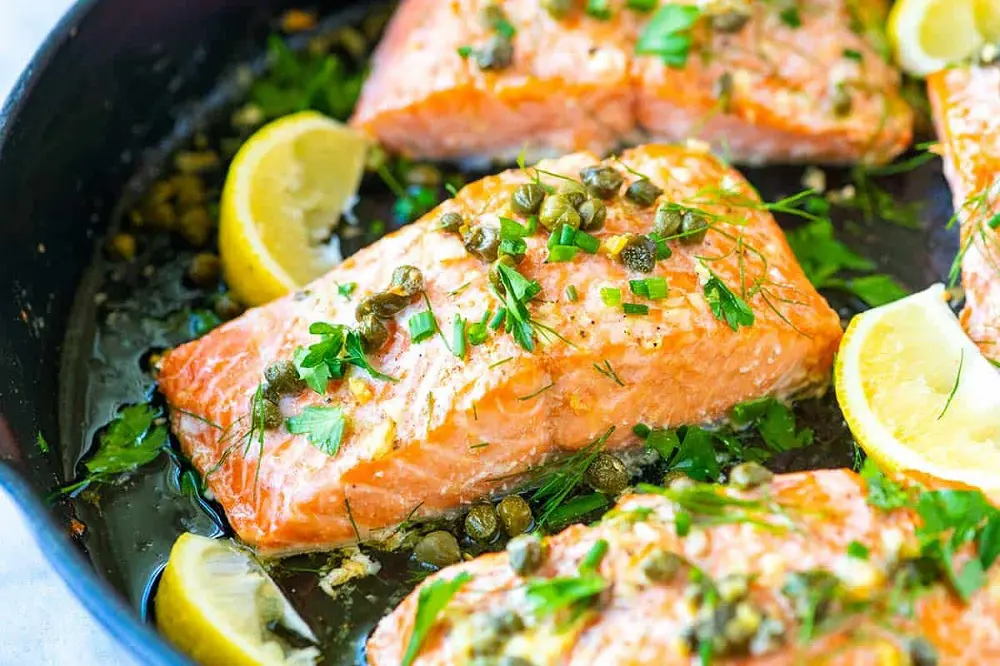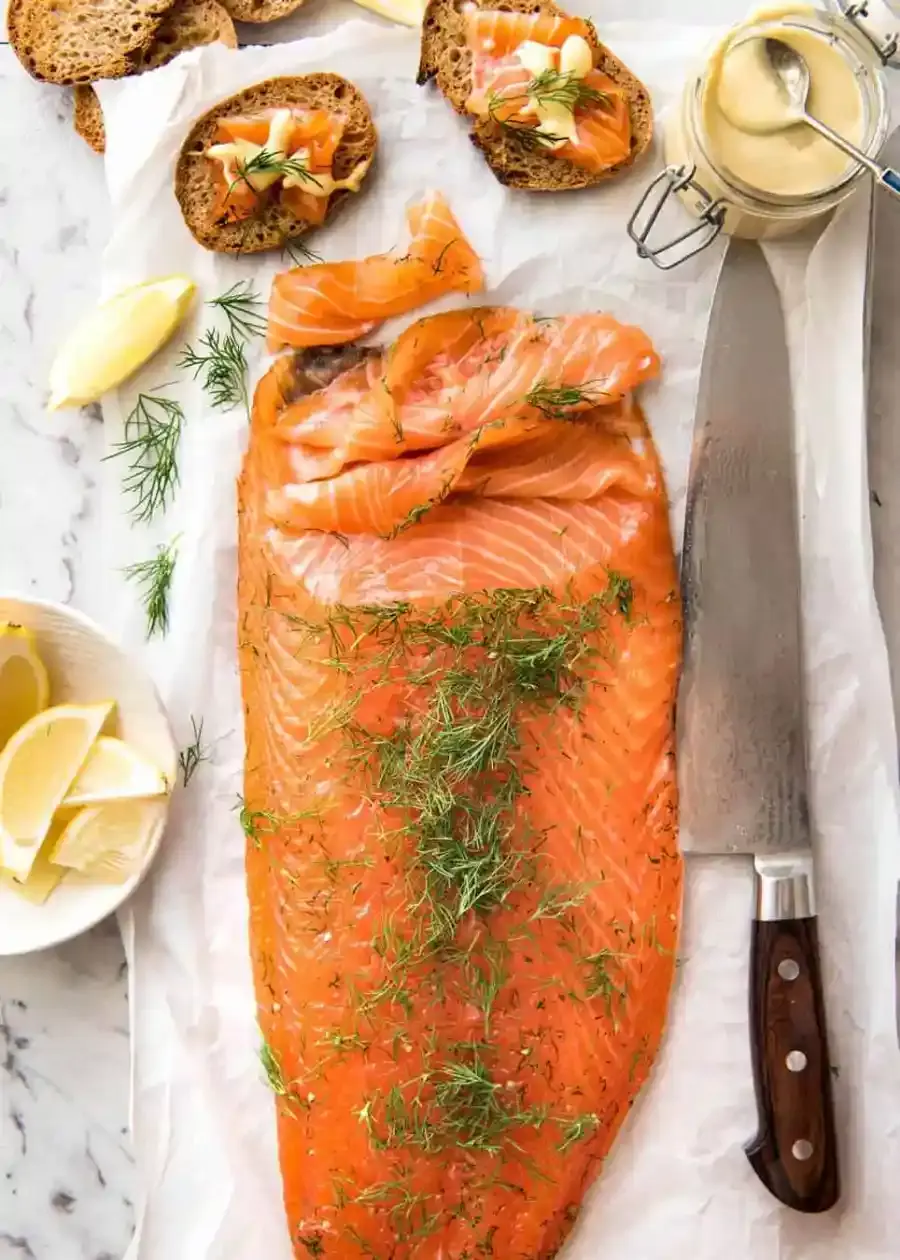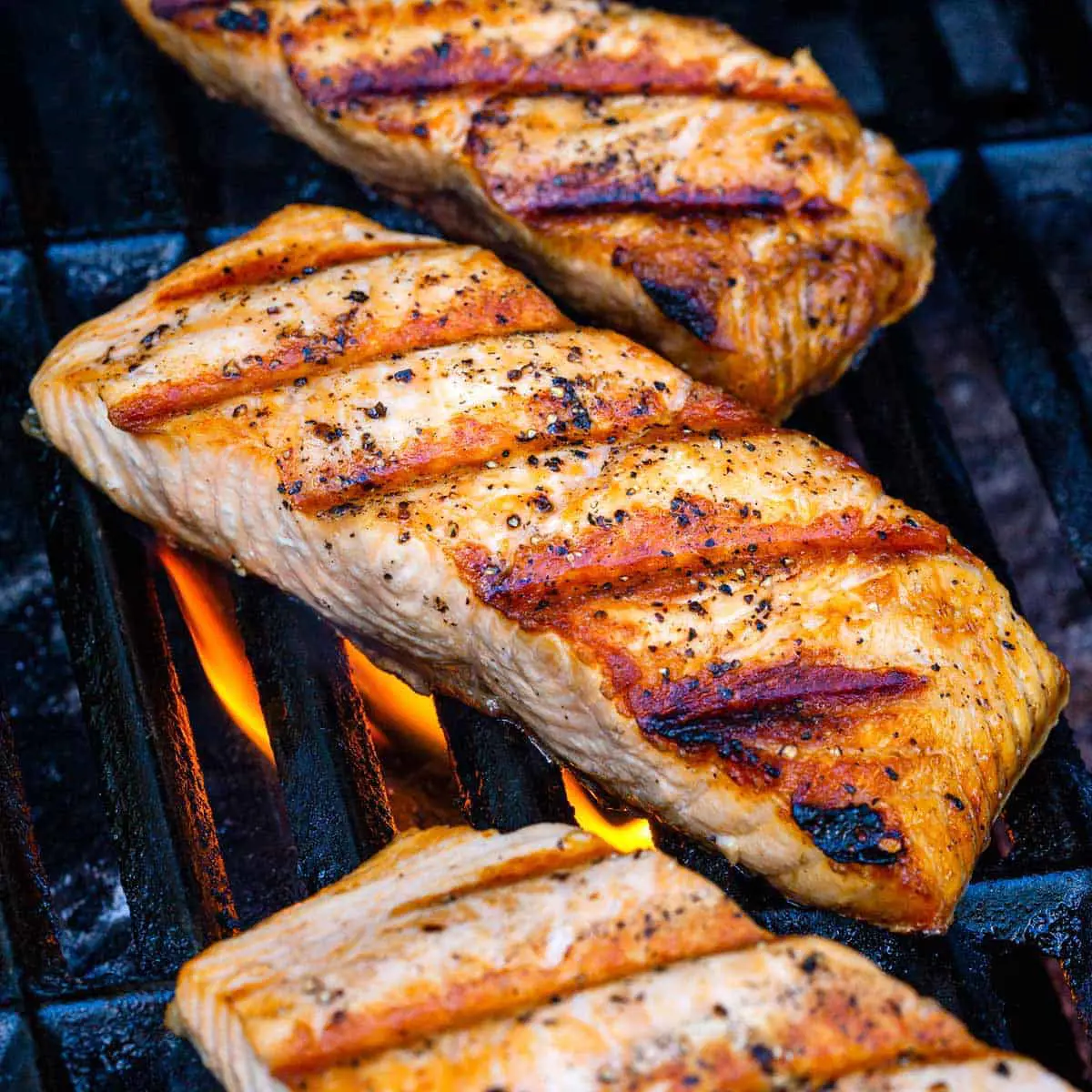How To Bake The Best Salmon In The Oven
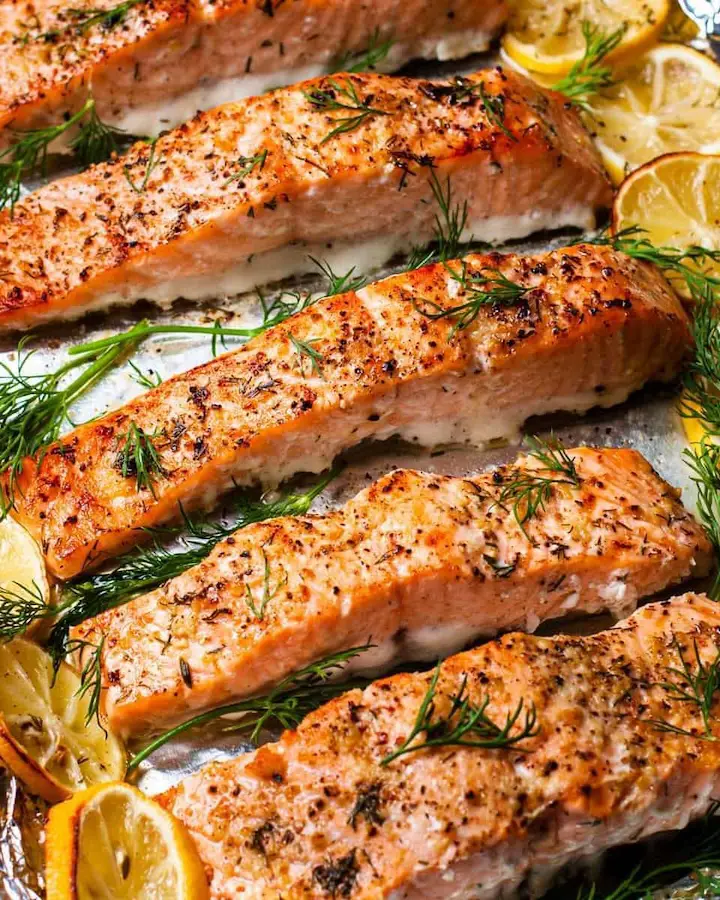
Baked salmon is a go-to option for a quick and healthy weeknight dinner. It’s packed with nutrients, full of flavor, and pairs well with almost any side dish. Despite its benefits, many home cooks shy away from making salmon, assuming it’s difficult to prepare.
But that’s no longer the case! This foolproof baked salmon recipe is not only incredibly easy but also visually stunning. Plus, we’re sharing expert tips and tricks to help you achieve perfectly tender, flaky salmon every time. Whether you're a beginner or an experienced cook, this guide will make salmon your new favorite dish.
Ingredients You Will Need
As we’ve already mentioned, this baked salmon recipe is incredibly easy to make. The key to its delicious flavor lies in a simple yet flavorful fresh lemon butter sauce. All you need are a few basic ingredients:
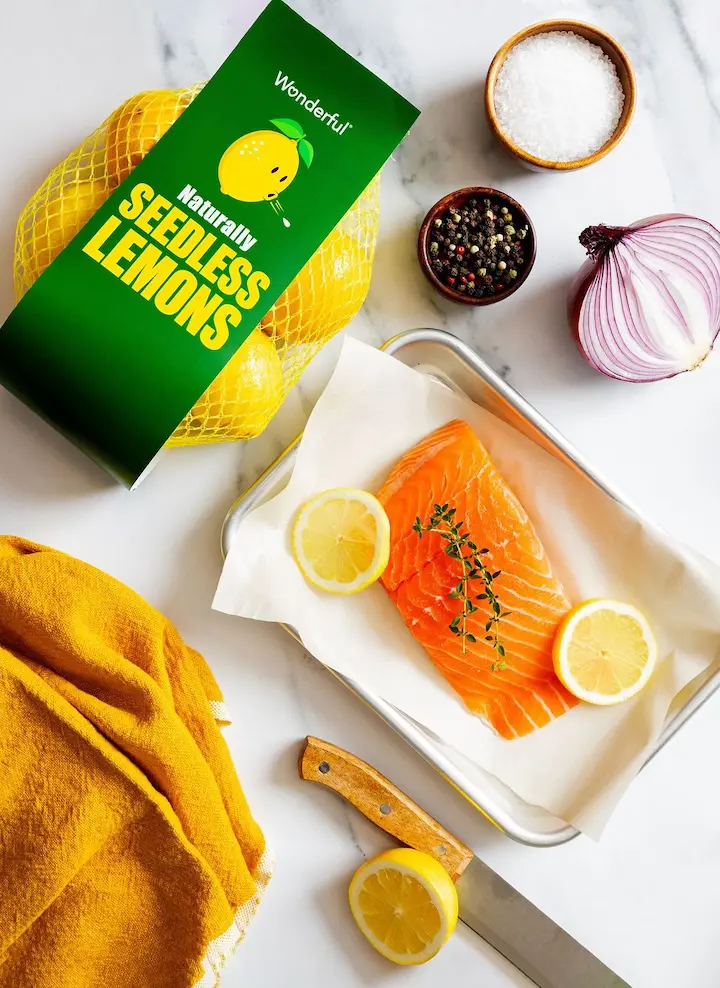
- Salmon: We recommend using fresh, light pink salmon fillets for the best flavor and texture. However, frozen fillets work just as well—just ensure they’re free from freezer burns. This recipe is also great for larger salmon cuts.
- Butter: Butter enhances the richness of the fish while keeping it moist and flavorful. If you prefer a lighter option, feel free to substitute it with olive oil or any other vegetable oil.
- Lemon Juice: Salmon and lemon are a perfect match! You can either bake the lemon slices alongside the salmon or use freshly squeezed lemon juice to create a tangy sauce, as we do in this recipe. One medium-sized lemon is usually enough, but you can add more for extra zest.
- Salt and Pepper: Season to taste—because no one likes a bland dish! A simple sprinkle of salt and pepper enhances the natural flavors of the salmon.
- Herbs: Fresh herbs add a burst of freshness. We use chopped parsley and dill in this recipe, as they pair beautifully with salmon. Feel free to experiment with your favorite herbs.
- Garlic: Freshly minced garlic (about 2–3 cloves) adds depth and a delicious aroma to the salmon.
How To Bake Salmon In The Oven
Baking salmon in the oven is an easy and quick way to enjoy a delicious, healthy meal. This recipe takes just 15 minutes and guarantees juicy, flavorful salmon with a perfect texture.
Follow this step-by-step guide to bake the best salmon at home:
1. Prepare the Salmon
Start by patting the salmon fillets dry with a paper towel. Removing excess moisture is essential as it helps achieve a crispy, golden skin while baking.
For frozen salmon: If using frozen fillets, thaw them overnight in the refrigerator or place them in a sealed bag under cold running water for quick thawing. Avoid thawing salmon at room temperature to prevent bacterial growth.
Room temperature matters: Before baking, let the salmon sit at room temperature for about 15 minutes. This ensures even cooking and a tender, flaky texture.
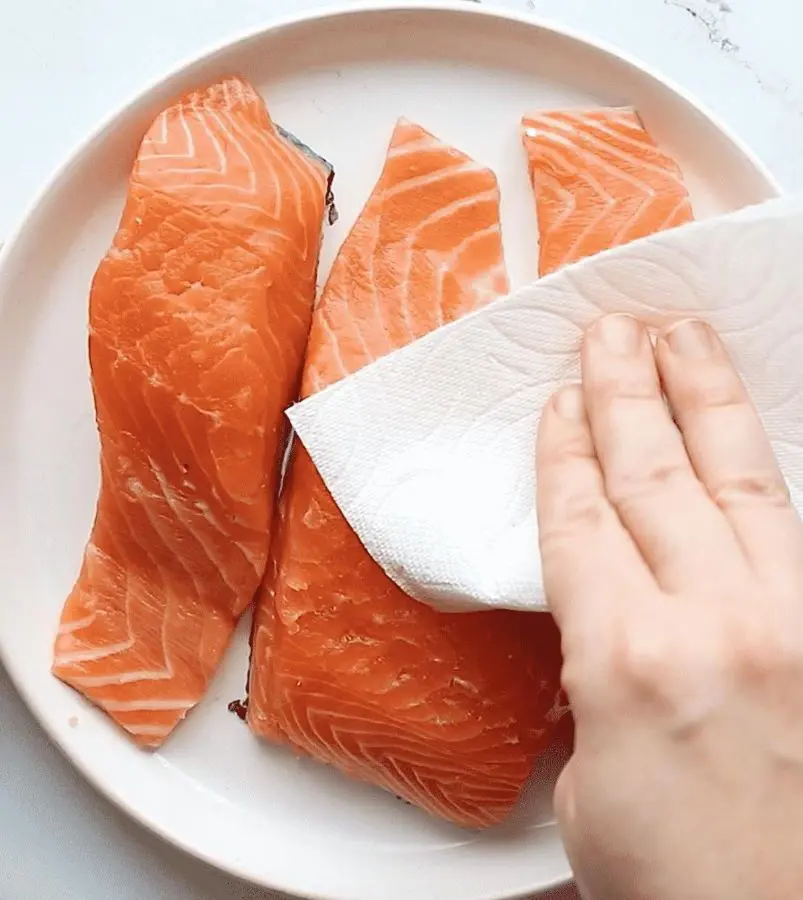
2. Season the Salmon
Next, prepare a flavorful seasoning mix to enhance the taste of your salmon.
In a small bowl, mix:
- 2 tbsp melted butter (for richness and moisture)
- 1 tbsp fresh lemon juice (to brighten the flavors)
Brush this mixture over the salmon, making sure to coat all sides evenly.
In another bowl, combine:
- 1 tsp garlic powder or minced garlic
- ½ tsp paprika (optional, for color and a mild smoky flavor)
- ½ tsp salt & black pepper (adjust to taste)
Rub the dry seasoning evenly over the fish. The butter-lemon mixture helps the seasoning stick while adding moisture to the fillet.
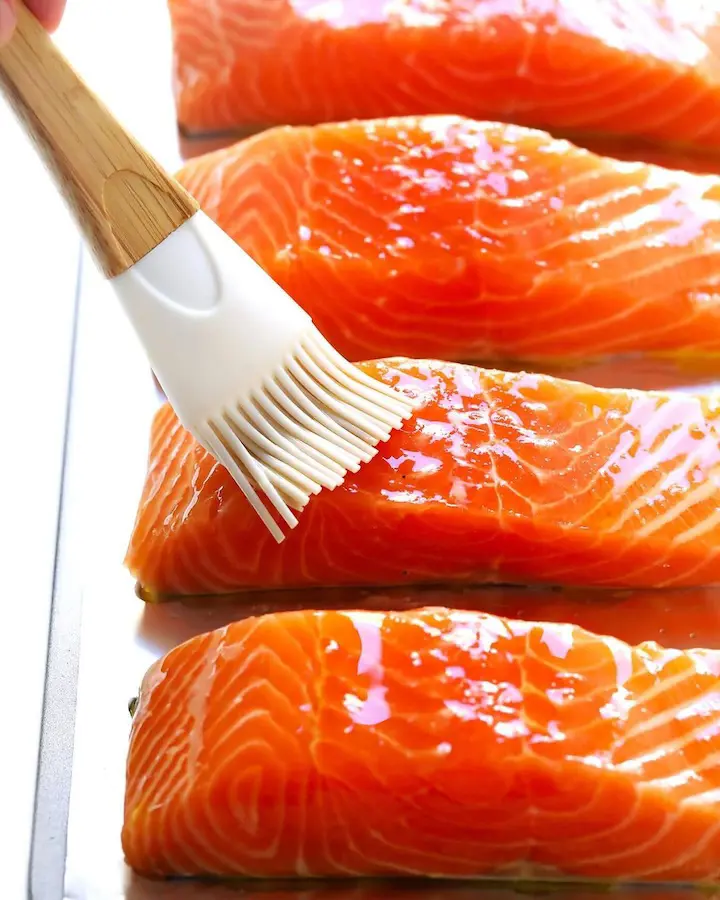
3. Bake the Salmon
Preheat your oven to 400ºF (200ºC) and place the seasoned salmon on a lined baking sheet.
Cooking time:
- For thinner fillets (½ inch thick): 10 minutes
- For thicker fillets (1 inch or more): 12-15 minutes
How to check doneness:
At the 8-minute mark, check the salmon using a fork. If it flakes easily and has a light pink, opaque color, it's done. If it's still translucent in the center, bake for a couple more minutes.
For precise results, use a food thermometer—145°F (63°C) is the ideal internal temperature for perfectly cooked salmon.
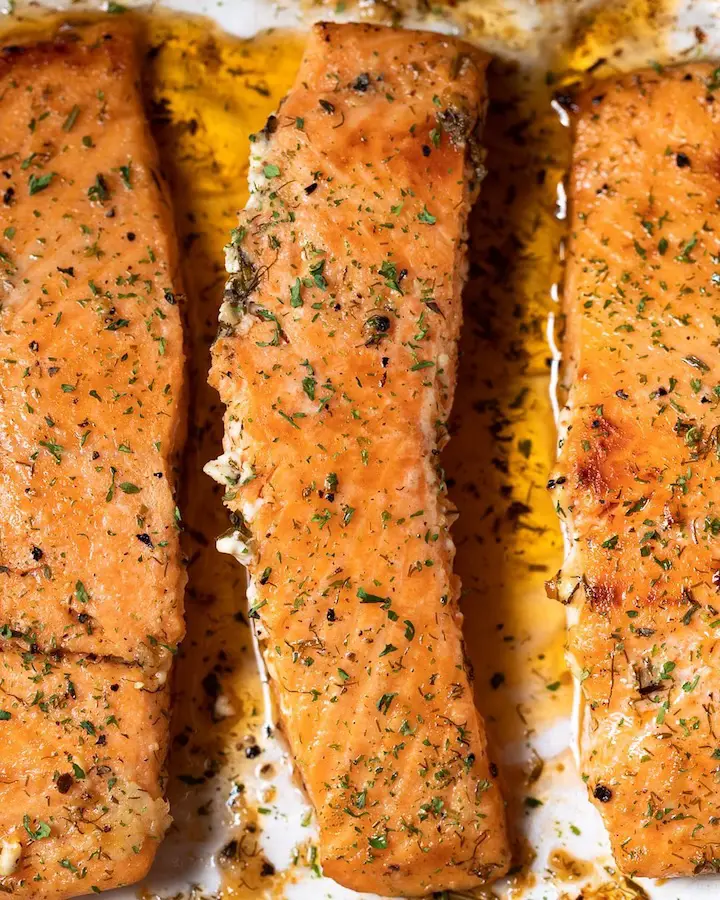
4. Garnish and Serve
Once baked, remove the salmon from the oven and let it rest for 2-3 minutes. This allows the juices to redistribute, keeping the fish moist.
For extra flavor, garnish with:
- Fresh chopped parsley or dill
- A sprinkle of lemon zest
- A drizzle of extra virgin olive oil
Serve with your favorite sides, such as roasted vegetables, steamed rice, or a fresh salad.
Enjoy your perfectly baked salmon!
What Is The Best Temperature For Salmon
Just like cooking time, temperature is a key factor in baking salmon. The right temperature depends on the size and preparation method of the fish.
- For salmon fillets: Bake at 400ºF (200ºC) for the best balance of a crispy exterior and a tender, juicy inside.
- For a whole salmon or a larger fillet (around 2 pounds) wrapped in foil: Use a slightly lower temperature of 375ºF (190ºC). This ensures even cooking while keeping the fish moist.
How Long To Bake Salmon In The Oven
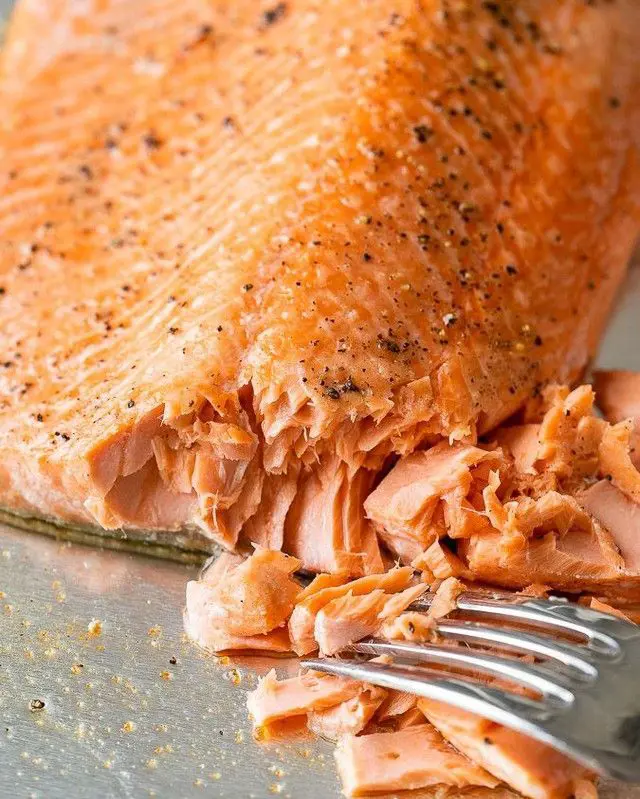
The baking time for salmon depends on its thickness and oven temperature. At 400ºF (200ºC), salmon fillets typically take 10-15 minutes.
A whole or foil-wrapped salmon at 375ºF (190ºC) may need 20-25 minutes. Always check doneness by ensuring the internal temperature reaches 145ºF (63ºC) or the flesh flakes easily.
Tips For Perfectly Baked Salmon
- Keep The Skin On: We suggest you leave the skin on the salmon as it creates a barrier between the fish and the heat source. This way you can protect the moisture on the fish and keep it from being dry. Similarly, the skin also becomes crispy at the end, bringing a textural difference to the dish.
- Cook Immediately After Seasoning: Always cook your salmon within 10 minutes after seasoning. Since the seasoning mixture contains lemon juice, the acidity can affect the flavor and texture of the fish if kept for too long.
- Put Under The Broiler For Cripsy Top: Another way to achieve the crispy top is by cooking the salmon in the broiler for a few minutes. Do not broil for more than 3 minutes as it can dry up your salmon significantly.
- Don’t Overcook: It’s best to undercook your salmon than overcook. This is because overcooked salmon is dry and rubbery. However, if the salmon is not quite cooked, you can simply remove it from the oven and cover it. The fish will keep on cooking even at room temperature because of the heat trapped.
Choosing The Right Salmon
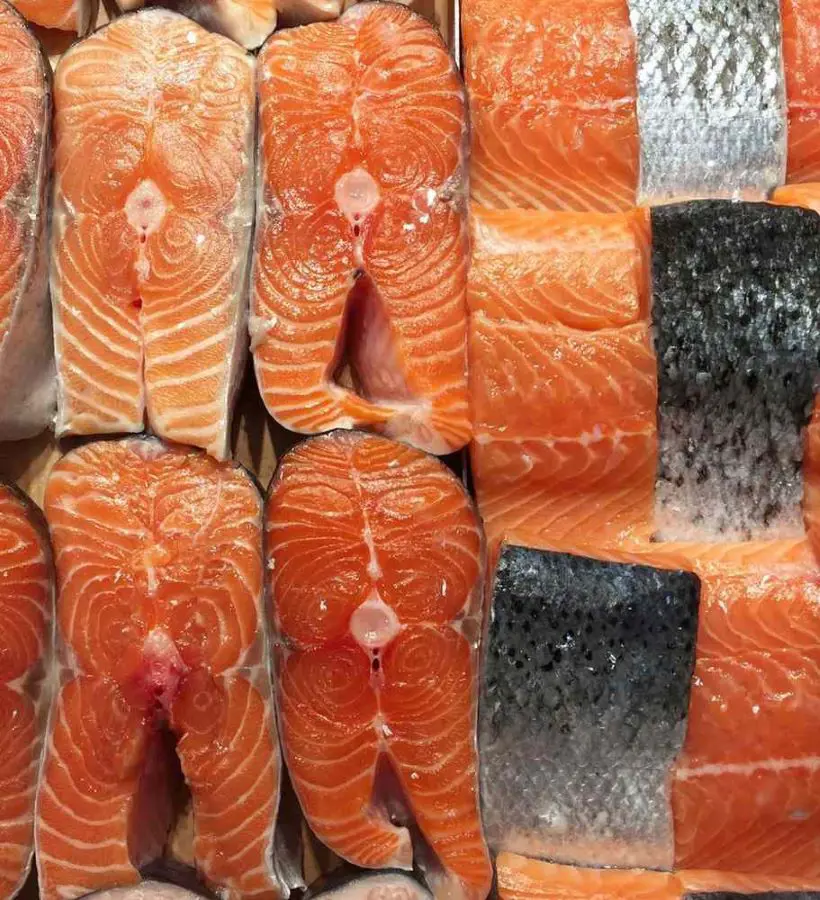
Choosing the right salmon is crucial for baking it to perfection. Here are some key points to consider:
Quality of Salmon
Select salmon that is fresh, vibrant, and sustainably raised. Avoid salmon with discoloration, a slimy texture, or a strong fishy smell.
Types of Salmon
There are several types of salmon to choose from, each with its unique flavor and texture.
- Atlantic Salmon: This salmon is known for its mild flavor and tender texture.
- King Salmon (Chinook): Rich and fatty with a buttery texture.
- Sockeye Salmon: Deep red flesh with a stronger flavor.
- Coho Salmon (Silver): Medium fat content and a delicate taste.
- Pink Salmon: Light in color and flavor, often used for canned salmon.
Wild Caught vs Farm-Raised
Wild-caught salmon is generally considered more nutrient-dense and sustainable, while farm-raised salmon is more affordable and available year-round.
Fresh vs. Frozen
When it comes to choosing salmon, you have the option of fresh or frozen. Fresh salmon is often preferred for its texture and flavor, but frozen salmon can be just as good, especially if it's flash-frozen immediately after being caught.
Thickness of Fillets
Choose salmon fillets that are about 1 inch thick. This ensures even cooking and prevents overcooking or undercooking.
Other Ways To Bake Salmon
While baking on a sheet oan is a popular and convenient method, there are several other ways to bake this delicious fish. Here are a few alternative techniques:
Baking Salmon in Foil
- Preparation: Cut large pieces of aluminum foil to wrap each salmon fillet individually.
- Seasoning: Place the salmon in the center of the foil, season, and add a slice of lemon and a spring of dill.
- Sealing: Fold the sides of the foil over the salmon to create a sealed packet.
- Baking: Place the packets on a baking sheet and bake in the preheated oven.
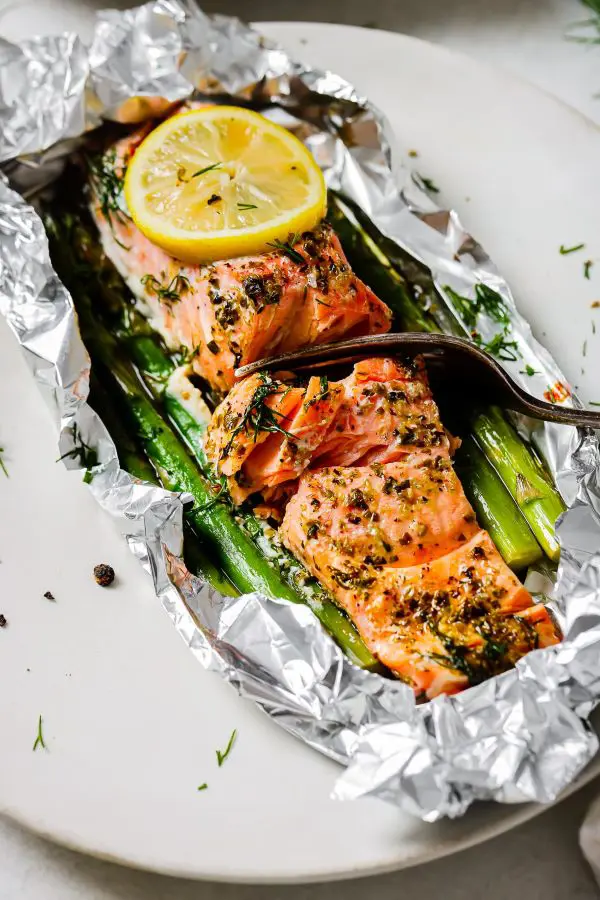
Baking Salmon on a Cedar Plank
The method of cooking salmon on a cedar plank imparts a delicious, smoky flavor to the fish. Soak the cedar plank in water for at least 30 minutes before using. Place the salmon on the plank, season as desired, and bake at 375 degrees F for 15-20 minutes.
Serving Suggestions
The beauty of baked salmon is that it goes with plenty of different sides. It works with veggies as well as something indulgent like mashed potatoes or mac and cheese.
If you’re serving it with veggies, roasted green beans is the best option but it also goes well with roasted Brussels sprouts or even air-fried potatoes.
Interestingly, you can also serve salmon with some rice, if you’d like.
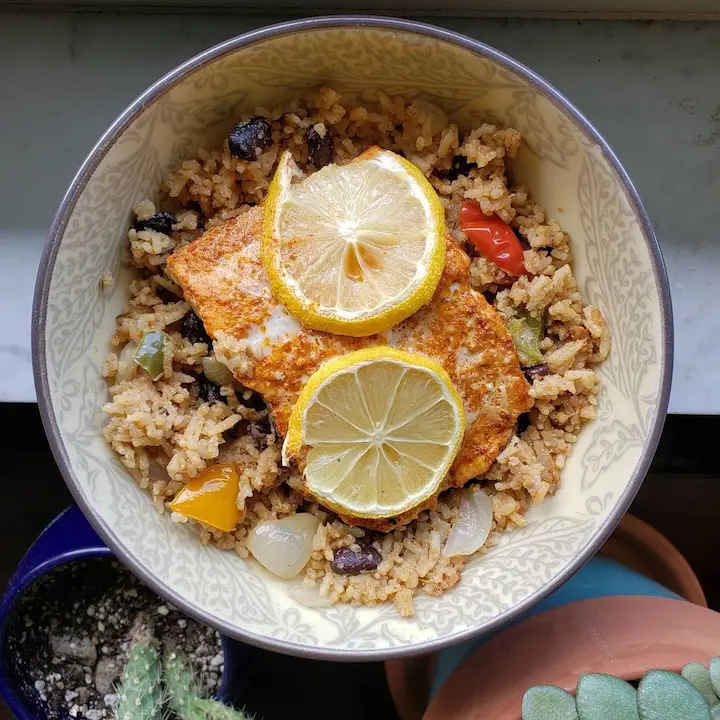
How To Store and Reheat Salmon
In order to store salmon, simply put it in an air-tight container and place it in the fridge for up to a week. To ensure that the fish doesn’t go dry, cover it with aluminum foil.
Reheating salmon is also quite easy. You can do it in the oven, over the pan or in the microwave. We suggest you not reheat your salmon in the microwave because it can be quite dry.
When reheating in the oven or a pan, use low and slow heat with a splash of water. Adding water helps the fish retain its moisture.
Recent posts
Recipe
Recipe
How To Cook Southern-Style Collard Greens
Cooking Southern-style collard greens is a beloved tradition of Southern cuisine, known for its comforting, rich, and savory flavors. These greens are slowly simmered until tender, resulting in a hearty and flavorful dish. Often prepared with smoked ...
Recipe
Best Herbs and Spices For Seasoning Salmon
Salmon is the culinary chameleon of the seafood world. It goes with everything, from light summer salads to comforting pasta dishes. Need a fast salmon fillet sizzling and without complicated recipes? The secret lies in perfect seasoning. With the ri...
Recipe
Garlic Butter Salmon Recipe
Garlic butter salmon is not only a culinary delight but also a nutritional powerhouse, offering a delectable blend of flavors and numerous health benefits. This dish combines the rich taste of salmon with the aromatic and savory notes of garlic ...
Recipe
A Comprehensive Guide To Perfect Salmon Gravlax
Salmon gravlax is a luxurious, flavorful dish that captures the essence of Scandinavian culinary tradition. This delicacy, made by curing salmon with a mixture of salt, sugar, and dill, is surprisingly easy to prepare at home. In this comprehensive g...
Recipe
14 Grilled Salmon Recipes For Perfect Summer Dinner
Salmon is possibly the most reliable dinner option for many households throughout America. So, we are confident that you already have an array of salmon-baked recipes on your corner. What we have brought for you today are grilled salmon recipes so yo...
Recipe
Best Smoked Salmon Appetizer Recipe
Smoked salmon appetizers are a timeless and elegant choice for any gathering. These offer a perfect balance of rich, smoky flavors and fresh, vibrant ingredients. These have become synonymous with casual brunches as well as upscale gatherings because...

